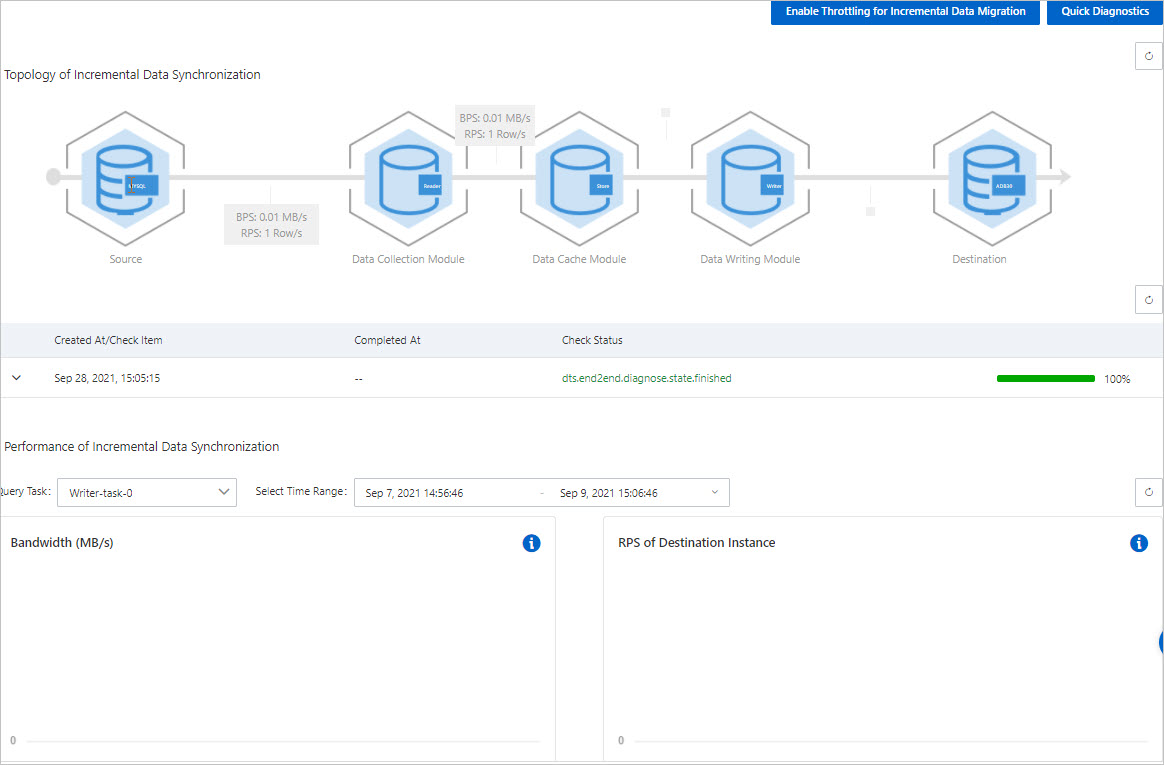In the Data Transmission Service (DTS) console, you can view the topology and performance of data migration and data synchronization tasks. DTS provides connection and performance metrics to help you manage tasks. DTS also provides the task diagnostics feature to help you identify and solve issues.
- Log on to the DTS console.
- At the top of the page, select the region where your instances reside.

- In the left-side navigation pane, click Data Synchronization or Data Migration. Note This topic uses a data synchronization task as an example.
- On the Data Synchronization page, click the ID of the data synchronization instance.
- Perform one of the following operations based on the synchronization type:
- View the topology and performance of full data synchronization.
- In the left-side navigation pane, choose .
- On the page that appears, view the topology of full data synchronization, select a time range to view the trend charts of performance metrics for full data synchronization, or click Quick Diagnostics to check whether the task is running as expected.

Feature Description Topology of Full Data Synchronization You can view the read/write performance and network information about the connections between DTS and the source and destination databases. The following parameters are provided: - Connection between DTS and the source database
- BPS: the amount of data that DTS reads from the source database per second. Unit: MB/s.
- RPS: the number of records that DTS reads from the source database per second.
- Network Latency: the network latency between DTS and the source database.
- Connection between DTS and the destination database
- BPS: the amount of data that DTS writes to the destination database per second. Unit: MB/s.
- RPS: the number of records that DTS writes to the destination database per second.
- Network Latency: the network latency between DTS and the destination database.
Quick Diagnostics You can check the performance of the source database, destination database, network, and DTS during full data synchronization. DTS provides diagnostic results and solutions. To use this feature, perform the following steps: - In the upper-right corner of the page, click Quick Diagnostics.
- In the message that appears, click OK.
- Refresh the page to view the diagnostic progress. If an exception occurs, click the
 icon to view diagnostic results and solutions.
icon to view diagnostic results and solutions. 
Performance of Full Data Synchronization You can view the bandwidth, records per second (RPS), read/write response time, and network latency. Note To view the description of performance metrics, move the pointer over the icon in the upper-right corner of a trend chart.
icon in the upper-right corner of a trend chart. - Connection between DTS and the source database
- View the topology and performance of incremental data synchronization.
- In the left-side navigation pane, choose .
- On the page that appears, view the topology of incremental data synchronization, select a time range to view the trend charts of performance metrics for incremental data synchronization, or click Quick Diagnostics to check whether the task is running as expected.

Feature Description Topology of Incremental Data Synchronization You can view the data transmission status and network latency between DTS modules and the source and destination databases. DTS modules include the data collection module, the data cache module, and the data writing module. The following parameters are provided: - BPS: the bandwidth between DTS modules. Unit: MB/s.
- RPS: the number of records that are transmitted between DTS modules per second.
- Network Latency: the network latency between DTS modules.
Quick Diagnostics You can check the performance of the source database, destination database, network, and DTS during incremental data synchronization. DTS provides diagnostic results and solutions. To use this feature, perform the following steps: - In the upper-right corner of the page, click Quick Diagnostics.
- In the message that appears, click OK.
- Refresh the page to view the diagnostic progress. If an exception occurs, click the
 icon to view diagnostic results and solutions.
icon to view diagnostic results and solutions. 
Performance of Incremental Data Synchronization You can view performance information such as the bandwidth, RPS, and synchronization latency. You can select metrics from the More Metrics drop-down list. The following metrics are provided:
- Bandwidth: the amount of data that is written to the destination database per second. Unit: MB/s.
- Synchronization Performance (RPS): the number of records that are written to the destination database per second.
- Synchronization Latency (s): the difference between the timestamp of the latest synchronized data in the destination database and the current timestamp in the source database.
- Executed DDL Operations: the number of DDL operations that are executed in the destination database within the selected time range.
- Latency (ms): the difference between the time when a data record is generated in the source database and the time when the data record is written to the destination database. For example, if a data record is generated in the source database at 7 o'clock and DTS writes the data record to the destination database at 8 o'clock, the task is delayed by 1 hour.
- Slow SQL Queries: the number of slow SQL queries that are generated in the destination database within the selected time range.
- View the topology and performance of full data synchronization.